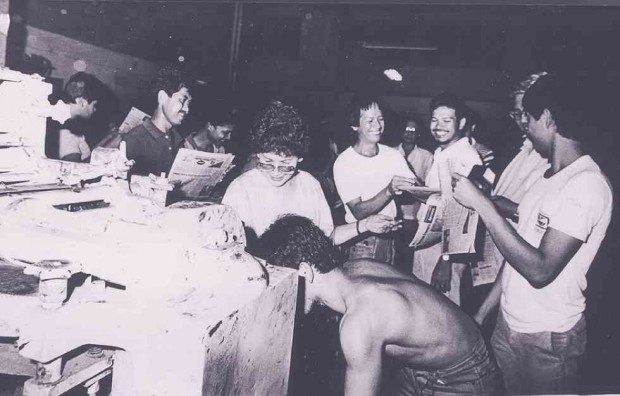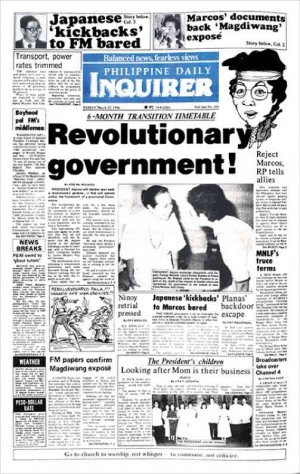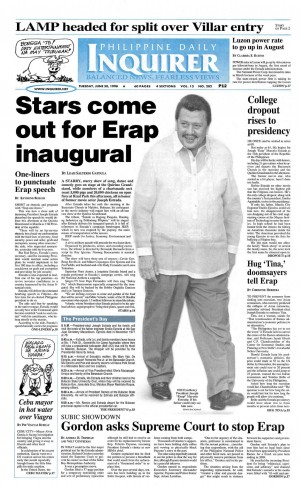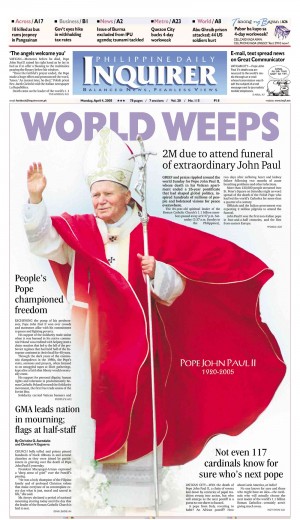From print to multimedia organization: The Inquirer story
1985: Philippine Daily Inquirer
The year was 1985, two years after the assassination of opposition leader Sen. Benigno Aquino Jr.
Founder Eugenia D. Apostol wanted a ‘broadsheet like no other’ to bravely report on the Sandiganbayan trial of the Aquino-Galman double murder case to chronicle the court proceedings meant to determine whether Rolando Galman, who was shot dead by Aviation Security men, was indeed Aquino’s assassin as had been claimed by the Marcos administration. Apostol had already been publishing a weekly Mr. & Ms. Special Edition to chronicle the unfolding events.
“The newspaper would be fearless in the face of repression…unflinching in its commitment to the truth …,” Apostol recalled her vision for the paper in the Inquirer’s commemorative book, ‘From Ninoy to Noynoy.’
With her handful of Mr. & Ms. staff, the Philippine Weekly Inquirer was born. The name derived from Philadelphia Inquirer, as proposed by editor in chief Letty Jimenez-Magsanoc, who had lived for some time in Philadelphia.
Apostol planned to close the weekly after the trial. But Marcos called for a snap election, and she saw the opportunity for a daily.
“Which is why, with fire in the veins, heart pounding, fist clenched, eyes closed and armed only with the courage of our doubt, we said ‘Let’s do it!’,” Apostol said, recalling the moment they made the decision.
On Dec. 9, 1985, the first issue of the Philippine Daily Inquirer rolled off the press with its banner story— “It’s Cory-Doy”. It didn’t even have a slogan, and so atop its masthead was a kicker: ‘A slogan? Help us write one and win a prize.’ The maiden issue, all 30,000 copies, sold out at P2 each.
“The job of a newspaper is to report the news. That in a word, is what the Philippine Daily Inquirer is all about,” said the paper in its first editorial ‘A statement of Purpose, Separating news from views,’ written by its first publisher, the late Max Soliven.
Noting that they lived in very interesting times, the editorial said the PDI will “chronicle these times with candor, and we trust, with courage.”
It was one of three alternative dailies that bannered the flight of the Marcoses at the height of the 1986 Edsa People Power Revolution.
The first Inquirer issues looked like an unmade bed, recalled managing editor Jose Ma. Nolasco. ‘We didn’t have money, we didn’t have a printing press. We had stories on page one. [Those issues] will never win any design competition,” he said.
“When we established the Inquirer, we didn’t think that one day it would be No. 1. Never did it cross our minds,” Nolasco said in a recent strategic planning session.
Chronicling the mounting public opposition to the Marcos regime, PDI’s circulation grew from just 30,000 to more than 250,000 by the time the snap election was held in February, 1986.
In just five years, in 1990, the Inquirer overtook another daily to become the biggest circulated broadsheet in the country as validated by a circulation audit done by Sycip, Gorres and Velayo. Since then, the Inquirer has kept its lead as the paper with the biggest circulation and readership.
As of latest reports, the 2015 First Quarter Consumer and Media View survey of The Nielsen Co., the Inquirer remains the top choice of 52.7 percent of ABC1 newspaper readers in major urban areas in the country.
The Manila Bulletin was a far second with a 34.3-percent readership, and the Philippine Star, placed third, with a 16.6-percent readership.
The Inquirer has also consistently ranked among the Top 1,000 companies in the Philippines.
The country’s paper of record, the Inquirer has chronicled the country’s history over the last quarter century. From the 1986 Edsa Revolution, the Inquirer was at the forefront of covering major upheavals, momentous events and powerful stories that changed the course of the nation’s history.
From the installation of Aquino’s widow Corazon Aquino in 1986, to her death in 2009 that led to the election of her only son Benigno “Noynoy” Aquino as President in 2010; from the unforgettable visits of Pope John Paul II in 1981 and 1995, and Pope Francis in 2015, to the devastating earthquake in 1990, the eruption of Mt. Pinatubo in 1991 and the horrific Supertyphoon “Yolanda” in 2013; from the Senate vote to end the US military bases agreement in 1991, to the Centennial of Philippine Independence in 1998, when the Inquirer first published in full color.
Unequalled in its courageous reporting, the Inquirer played its watchdog role in the ouster of the corruption-plagued administrations of Joseph Estrada and the ascendancy of his predecessor, Gloria Macapagal-Arroyo.
To get back at the Inquirer for its exposes on his involvement in corruption, Estrada instigated an ad boycott against the paper on July 3, 1999 that lasted five months. The Inquirer survived on support from its loyal advertisers and readers who sent encouraging letters and even donations to keep the Inquirer going.
Fittingly enough, on its 30th year, the Inquirer broke the biggest expose in decades—the P10-billion pork barrel scam perpetrated by businesswoman Janet Napoles. The groundbreaking series by Inquirer senior reporter Nancy Carvajal, under the meticulous guidance of editor in chief Letty Jimenez-Magsanoc, brought about wide-ranging reforms in the government’s handling of taxpayer money and sent at least three influential senators behind bars.
The pork barrel scam also earned Carvajal and the Inquirer all the major journalism awards here and abroad for two years running.
From 30,000 copies on its maiden issue, the Inquirer is now read by 1.4 million people, with readership still growing.
1997: Inquirer.net
The Inquirer became the first broadsheet in the Philippines to get online when it launched Inquirer.net on Oct. 27, 1997.
“It started out as an experiment, JV Rufino, director for Inquirer mobile, said about the launch of the website. The advent of the Internet created an opportunity for a new platform to deliver the news. By this time, the newspaper had also completed its conversion from the outdated manual newsroom operations to a computerized system.
Inquirer.net, with Paolo Rufino Prieto as president, went online with a handful of staff in one room on the fourth floor of the PDI building, starting off as a mirror image of the newspaper to cater to readers who access their news through desktop computers.
The 24/7 news cycle, spawned by online sites and cable television, prompted the setting up of INQ7 Interactive on Feb. 27, 2001. A joint venture between the Inquirer and GMA 7, it was intended to integrate print, TV, radio and other media with the Web to deliver content to consumers anytime, anywhere. As equal partners, Inquirer and GMA7 delivered the country’s first multimedia platform. The joint venture ended in 2007.
Inquirer.net reverted to its role as the country’s pioneering breaking news platform, special sites and interactive features to the fast-growing digital audience. It started holding office at the Rufino Building on Ayala Avenue in Makati City.
Since then, the website (familiarly referred to within the Inquirer family as DotNet) has served as one of the country’s leading news destinations online, growing strongly and steadily through the years. It is currently the 12th most visited site in the Philippines, just behind Wikipedia and Amazon.
“DotNet’s purpose is to extend the Inquirer’s brand of ‘first, fair, fearless’ journalism to an audience that is increasingly digital, online. It seeks to serve this online audience by making PDI content available, by adding news and compelling features of its own, by multiplying its menu of affiliated sites, and by contributing a fourth “f-word” to the mix: “fast,” said Inquirer.net editor in chief John Nery.
He said that as of October 15, 2015, the website’s most important metric—unique users per month—stood at 9.7 million, up 30 percent over a year ago.
“In other words, the audience for DotNet has expanded by almost a third, or over 2.2 million new unique visitors, in the last 12 months,” he said.
During the Pacquiao-Mayweather fight in May 2015, Nery said Inquirer.net’s monthly uniques surged to a new audience peak of 15.7 million.
“Part of the reason for the strong and steady growth lies in the greater integration of social media assets into DotNet newsroom operations,” Nery said.
He noted that the strategic use of the Inquirer media group’s main social media accounts, on Facebook and on Twitter, has led to a greater proportion of website traffic coming from social media.
“But the truly encouraging development? The proportion of ‘direct’ traffic—visitors who go straight to the website without going through search or being referred by social—remains the same, at a high 40 percent or so. This means that the same proportion of the new audience has learned the habit of going to DotNet directly! [That’s] vigorous encouragement, for the exciting times ahead,” Nery said.
2009: Megamobile
Through an affiliate, the Inquirer acquired majority stake in Megamobile on Dec. 4, 2009 as its mobile arm, complementing Inquirer.net’s content. A digital content and applications developer, Megamobile expanded to web and mobile application developments, digital advertising, digital publishing and other digital initiatives of the Inquirer and its partners.
Megamobile developed the Inquirer mobile app through which subscribers can get breaking news and alerts on their smartphones.
Along with the mobile app, the Inquirer chat apps on Line, Kakao Talk, Viber, WeChat and SMS alerts have a total of over 661,000 subscribers as of October 2015.
In September 2015, the Inquirer marked a milestone when Megamobile debuted the Inquirer on Apple watch, making the Inquirer the first in the country to deliver breaking news on the device.
The Inquirer is also super social. To date, it has 1.3 million followers on Twitter and 1.4 million on Facebook.
In addition to its online and mobile products, the Inquirer also has the Inquirer Plus Digital Newsstand where subscribers can get an enhanced replica of the printed paper on their Apple iOS, Android and Windows 8.1 tablets and smartphones.
2001: Inquirer Publications Inc.
IPI was registered on Oct. 12, 2001 to develop community journalism and provide quality newspapers to different audiences from A to E. It publishes one national tabloid, Bandera, and one regional paper, Cebu Daily News.
Cebu Daily News: 1998
Before IPI was incorporated, the Inquirer marked its first community-oriented newspaper with the publication of Cebu Daily News on Feb. 8, 1998. CDN was also the first to introduce in the country a global trend in newspapers called the compact format. In 2015, CDN launched Cebu Libre, an offshoot of the free newspaper Inquirer Libre, distributed in ports and bus terminals in Cebu.
CDN is one of the biggest regional dailies in the Visayas, providing fearless, relevant and hard-hitting news and views.
Bandera: 2001
In its quest for a more diverse readership, the Inquirer acquired the Bandera and Tumbok tabloids from the Gokongweis on Nov. 7, 2001, although it later discontinued Tumbok.
From its racy origins, Bandera transformed the image of the traditional tabloid to a paper that offers news and livelihood tips with a healthy dose of the usual entertainment fare. With its tagline “Balita, Buenas, Chika,” readers may enjoy a daily rundown of all the latest showbiz happenings alongside much-awaited livelihood tips and current events.
Bandera, the No. 1 national tabloid in Visayas and Mindanao, is also among the top tabloids nationwide, according to the Nielsen Media Index 2012, Quarter 4. It is also very active on social media.
Inquirer Libre: 2001
Libre is the country’s most-read free newspaper distributed in all Metro train stations (MRT, LRT and PNR). With its tagline, “The best things in life are Libre,” it features snappy news and features in a fun, irreverent and quirky style suitable for the highly mobile lifestyles of the 800,000 or so commuters rushing off to school or work.
Libre’s maiden issue came out on Nov. 19, 2001. A certified hit for early morning commuters, Libre has a circulation of over 125,000 on weekdays.
Libre also has special distributions during UAAP and NCAA seasons, with its collegiate sports and lifestyle sub-title, Libre Varsity Action. Just recently, during the PBA games, it distributed its product extension, Libre PBA Hardcourt Action.
Chito de la Vega, Libre editor in chief, said the idea for a free paper came about when Inquirer management noticed the slow decline in newspaper readership, particularly among the youth and the C and D classes.
“Though C and D was traditionally not an Inquirer market, that group and the youth were coveted audience. The idea was that a free newspaper could arrest this decline and perhaps develop an audience untapped by PDI,” De la Vega said.
Exposure of Inquirer leaders to Wan-Ifra, the leading association of newspapers and pubishers, reinforced this plan, thus Project Freedom, the code name for the free paper, was launched.
2010: Radyo Inquirer
Completing its round up of news platforms, Radyo Inquirer dzIQ 990AM was launched in September 2010.
Operated by the Trans-Radio Broadcasting Corp., Radyo Inquirer shares the Inquirer’s zeal for balanced news and fearless views and its vast news-gathering network to bring together “the reach and immediacy of radio and the credibility of the newspaper.” Popular not only among drivers and passengers of public utility vehicles, dzIQ is now also heard in homes, public establishments and workplaces with up-to-the-minute news and relevant information.
1993: Print Town Group
Print Town Group is the largest privately owned newspaper and commercial printer in the Philippines. FEP Printing Corp., Alliance Media Printing Corp. Inc. and Lexmedia Digital Corp. form the Print Town Group.
FEP Print Corp. was primarily established in 1993 to serve the daily requirements of the Philippine Daily Inquirer. In 1996, Alliance Media Printing Inc. was formed as an expansion platform for printing other newspaper titles such as the Asian Wall Street Journal, International Herald Tribune, Cebu Daily News and Bandera.
Today, the PTG Newspaper Printing Division manages four press sites with 24/7 operations and highly trained manpower in strategic locations in Makati City and the provinces of Laguna, Cebu and Davao to meet on-time delivery commitments nationwide.
PTG offers an extensive line of advanced heatset, sheetfed and coldset web press services supported by its printing expertise in its main facility on a 10-hectare complex in Biñan, Laguna.
PTG’s coldset presses are capable of printing various newspaper sizes, comics, textbooks and other creative executions.
Lexmedia Digital Corporation was established in 2001 and pioneered the use of CTP or Computer-to-Plate technology, offering digital prepress services to newspaper and magazine publishers. In 2004, the company ventured into full service commercial printing and launched the country’s most modern facility in the Philippines. It specializes in the printing of books, magazines, catalogues, directories, calendars, posters, annual reports as well as packaging cartons and labels. The plant, located in Mamplasan, Binan City, Laguna, was awarded an ISO-14001 certificate confirming its compliance with international standards.
2008: Hinge Inquirer Publications (HIP)
The Inquirer Group marked its entry into the world of magazine publishing with the launch of HIP on Oct. 5, 2005.
HIP is the magazine arm of the Inquirer Group specializing in lifestyle and niche consumer magazines and free community publications.
Currently, HIP freezine titles include Red Magazine, Forbes In Touch, Dasmariñas Village Gazette, Southern Living, Northern Living, Turista, Multisport Philippines, Makati Leads and Soul BGC. Sold commercially in newsstands is F&B World magazine, the only trade publication that serves as guide to the foodservice industry.
HIP also has an active custom publishing unit that serviced the following clients to create recent projects such as: The SM ShopMag, Chefs on Parade CoffeeTable Book, UFS-Around the World in 80 Plates cookbook, GAP Gazette, Avida Living newsletter, Canon Frames Catalog and Inquirer Supplement, Samsung B2B Catalog, AdCongress Planner, Matimco Wood Living, GNC Live Well, Plantersbank SME Magazine, Sofitel brochure, Alveo CityWalk GuidesPond’s flyers, and so on.
As hip as its name, HIP creates some of the most dynamic and innovative titles in the magazine industry today, from fashion to sports, cosmetics to video games, from food to travel.
2008: DAG Xpress Courier Inc.
DAG Xpress Courier Inc. was set up in December 2008 to service the delivery and courier needs of publications, subscriptions, billing statements and promotional materials such as flyers and catalogs. It has more than 5,000 delivery points in Metro Manila, Tagaytay City and the rest of Cavite province.
These include convenience shops such as 7-11, Mini-Stop, Watsons, and Mercury Drug. Key accounts also include five-star hotels in Metro Manila, Starbucks, and Coffee Bean and Tea Leaf, as well as National Bookstores, Shopwise, Banco de Oro, Shell and Petron.
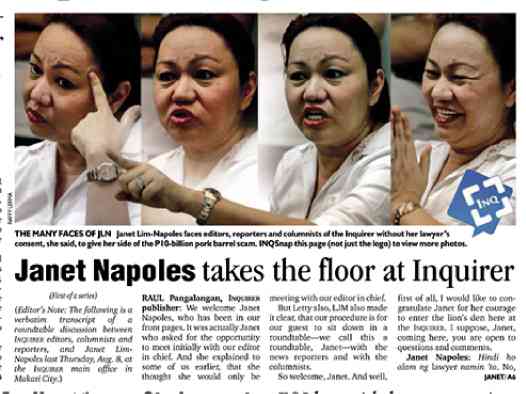
Formerly called the Inquirer Catalyst Media, IDO provides infotainment on the go. It is the first to introduce an out of home audio visual network information system that integrates global positioning system or GPS, with its passenger information system in the Philippines.
IDO’s Bus Channel features news and weather updates from the Inquirer.net website, selected music videos from YouTube and shows featuring “fun, light, friendly and modern programming” packaged just for bus riders. A pioneering digital innovation set up in 2012, the ICM Bus Channel can be viewed on 185 air-conditioned buses plying the Metro Manila and Luzon routes.
2015: Inquirer Academy
The youngest member of the Inquirer Group, Inquirer Academy was incorporated in January 2015, with the vision of empowering Filipinos through continuous learning.
InqA (short for Inquirer Academy), InqA offers workshops on communication, marketing, leadership and business innovation to professionals who want to further enhance their skills and come up with big ideas for their career and business.
The pilot program was held last May in partnership with Chatsworth Medi@rt (Mediart) Academy of Singapore through its MAD (Marketing, Advertising & Design) Program.
InqA use workshops rather than seminars to ensure application of skills. It is guided by the 70 + 20 + 10 learning rule, with 70 percent allotted to work application or case studies, 10 percent to the workshop proper, and 20 percent to coaching or feedback session.
(Source: Inquirer books, archives)
